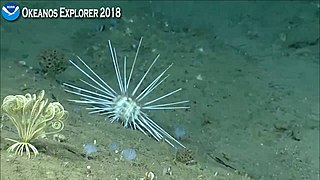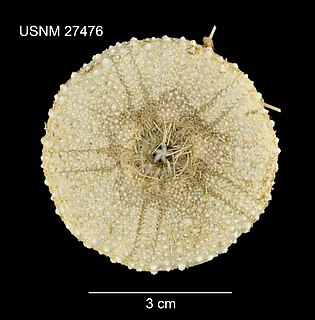
The Diadematidae are a family of sea urchins. Their tests are either rigid or flexible and their spines are long and hollow.

The Echinothurioida are an order of sea urchins in the class Echinoidea. Echinothurioids are distinguished from other sea urchins by the combination of a flexible test and hollow spines. The membrane around the mouth contains only simple plates, in contrast to the more complex mouth parts of their close relatives, the Diadematoida. They are nearly all deepsea dwellers.

The Camarodonta are an order of globular sea urchins in the class Echinoidea. The fossil record shows that camarodonts have been in existence since the Lower Cretaceous.

Apatopygus recens is a species of sea urchin of the family Apatopygidae. Their armour is covered with spines. It is placed in the genus Apatopygus and lives in the sea. Apatopygus recens was first scientifically described in 1836 by Milne-Edwards, French zoologist.
Aphanopora echinobrissoides is a species of sea urchin of the family Neolampadidae. Their armour is covered with spines. It is placed in the genus Aphanopora and lives in the sea. Aphanopora echinobrissoides was first scientifically described in 1903 by de Meijere.
Aporocidaris antarctica is a species of sea urchin of the family Ctenocidaridae. Their armour is covered with spines. It is placed in the genus Aporocidaris and lives in the sea. Aporocidaris antarctica was first scientifically described in 1909 by Ole Theodor Jensen Mortensen, Danish professor. It has a circum-Antarctic distribution.
Araeosoma belli is a species of sea urchin of the family Echinothuriidae. Their armour is covered with spines. It is placed in the genus Araeosoma and is found throughout the Caribbean Sea as well as areas around the Gulf of Mexico. Araeosoma belli was first scientifically described in 1903 by Ole Theodor Jensen Mortensen, a Danish zoologist.
Araeosoma violaceum is a species of sea urchin of the family Echinothuriidae. Its armour is covered with spines. It is placed in the genus Araeosoma and lives in the sea. A. violaceum was first scientifically described in 1903 by Ole Theodor Jensen Mortensen.

Calocidaris micans is a species of sea urchins of the Family Cidaridae. Their armour is covered with spines. Calocidaris micans was first scientifically described in 1903 by Ole Mortensen.
Chaetodiadema africanum is a species of sea urchins of the Family Diadematidae. Their armour is covered with spines. Chaetodiadema africanum was first scientifically described in 1924 by Hubert Lyman Clark.
Chaetodiadema japonicum is a species of sea urchins of the Family Diadematidae. Their armor is covered with spines. Chaetodiadema japonicum was first scientifically described in 1904 by Ole Theodor Jensen Mortensen.
Chaetodiadema keiense is a species of sea urchins of the family, Diadematidae. Their armour is covered with spines. Chaetodiadema keiense was first scientifically described in 1939 by Ole Theodor Jensen Mortensen.

Chaetodiadema pallidum is a species of sea urchins of the Family Diadematidae. Their armour is covered with spines. Chaetodiadema pallidum was first scientifically described in 1907 by Alexander Emanuel Agassiz and Hubert Lyman Clark.
Chaetodiadema tuberculatum is a species of sea urchins of the Family Diadematidae. Their armour is covered with spines. Chaetodiadema tuberculatum was first scientifically described in 1909 by Hubert Lyman Clark.

Chondrocidaris gigantea is a species of sea urchins of the Family Cidaridae. Their armour is covered with spines. Chondrocidaris gigantea was first scientifically described in 1863 by Alexander Agassiz.
Cidaris nuda is a species of sea urchins of the Family Cidaridae. Their armour is covered with spines. Cidaris nuda was first scientifically described in 1903 by Ole Mortensen.

Chaetodiadema is a genus of sea urchins of the Family Diadematidae. Their armour is covered with spines.

The Echinothuriidae are a family of sea urchins in the order Echinothurioida. Due to their soft skeletons, most are called "leather urchins", but species in the genus Asthenosoma are also known as "fire urchins" due to their bright colors and painful, venomous sting.

Gracilechinus is a genus of sea urchins in the family Echinidae.

Araeosoma is a genus of deep-sea sea urchins in the family Echinothuriidae.











